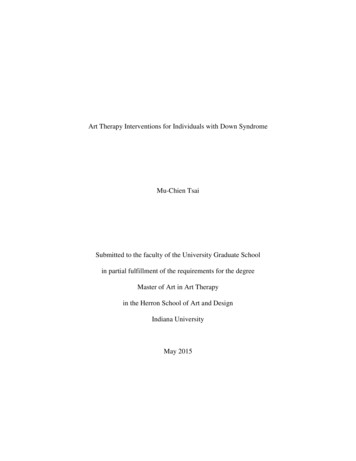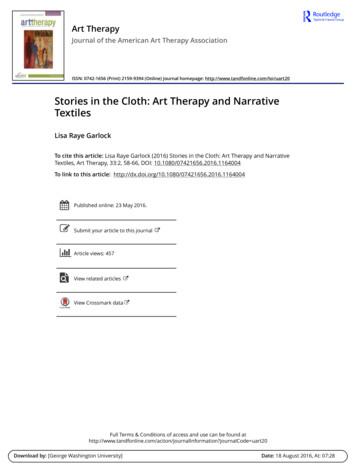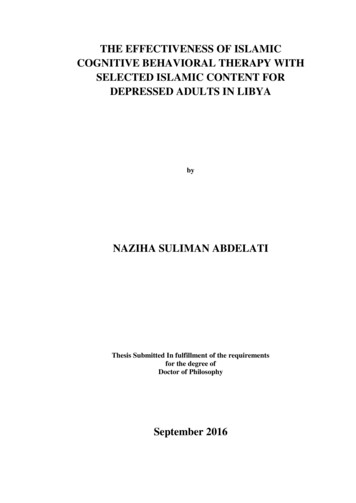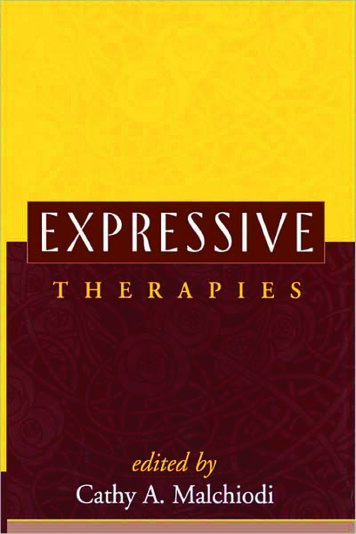
Transcription
Art Therapy Interventions for Individuals with Down SyndromeMu-Chien TsaiSubmitted to the faculty of the University Graduate Schoolin partial fulfillment of the requirements for the degreeMaster of Art in Art Therapyin the Herron School of Art and DesignIndiana UniversityMay 2015
iiART THERAPY INTERVENTIONSAbstractThis study was an integrative literature review exploring the research published on art therapyinterventions with individuals with Down syndrome. In order to expand the collected resources,secondary sources and expanded search terms, such as developmental disabilities and intellectualdisability, were used for gathering more data to support this study. Three important outcomeswere categorized: 1) Intellectual and communicative difficulties are present; 2) Developmentaland behavioral art therapy approaches and haptic art materials are particularly suitable forworking with developmentally impaired people; 3) Facilitating personal expression, improvingsocial skills, enhancing self-esteem, and fostering cognitive development are four therapeuticgoals for this population. Based on these outcomes and the analyses of the collected data, an arttherapy treatment plan for people diagnosed with Down syndrome was generated. Thelimitations and recommendations were also discussed.Keywords: Art therapy, art intervention, Down syndrome, developmental disabilities
iiiART THERAPY INTERVENTIONSDedicationThis thesis is dedicated to my mother, who inspires me to work with people who have specialneeds, and my father, who constantly supports me in various ways. I would also like toespecially thank my mentor and friends who continuously encouraged me during this process.
ivART THERAPY INTERVENTIONSAcknowledgementsI sincerely give thanks to Juliet King, Eileen Misluk, and Michelle Itczak for your continuoussupport, guidance, and reassurance. Every encouragement from you inspired and sustained me tocomplete this whole journey.
vART THERAPY INTERVENTIONSTable of ContentsAbstract . iiDedication . iiiAcknowledgements . ivTable of Contents . vCHAPTER I: INTRODUCTION .1A. Definition of Terms . . . .3CHAPTER II: METHOD . .5CHAPTER III: LITERATURE REVIEW . . .9A. Down Syndrome . . . . 91. Children with DS . . 92. Adults with DS . . 11B. Art Therapy Approaches with People who Have DS . . 121. Developmental art therapy . . 142. Behavioral art therapy . 15C. Expressive Therapies Continuum . .161. Kinesthetic/Sensory level . . 182. Perceptual/Affective level . . 193. Cognitive/Symbolic level . . 194. Creative level . . 20D. Down Syndrome and Developmental Disabilities . 20E. Art Therapy Goals for People withDown Syndrome and Developmental Disabilities . 21
viART THERAPY INTERVENTIONS1. Facilitate personal expression . . 222. Improve social skills . . 253. Enhance self-esteem . . 294. Foster cognitive development . . . 32F. Summary . . 36CHAPTER IV: RESULTS . . 38A. Proposed Art Therapy Treatment Plan for the Population with Down Syndrome . 391. Assessment . 412. Stage one . . . 423. Stage two . . 454. Stage three . 52CHAPTER V: DISCUSSION . . 65A. Limitations of the Study . . 66B. Implications for Future Research . 67CHAPTER VI: CONCLUSIONS AND RECOMMENDATIONS . 68REFERENCES 70
1ART THERAPY INTERVENTIONSCHAPTER I:INTRODUCTIONDown syndrome (DS) is a congenital disorder which occurs when a person has a full orpartial extra copy of chromosome 21 (Herron-Foster & Bustos, 2014). People diagnosed with DShave a range of physical difficulties and developmental delays in language, interpersonal skills,cognitive skills, self-esteem, and intellectual ability (Rogers, 2005; Sherman, Allen, Bean, &Freeman, 2007; Jackson, Cavenagh, & Clibbens, 2014). Many people with DS feel as thoughthey have limited control in their lives, and little chance for their voices to be heard (Lister,Snow, & D’Amico, 2009). Approximately one in six children were identified withdevelopmental delays in the United States from 2006 to 2008 (Boyle et al., 2011). The estimatednumber of people born with DS was one in 691 in the United States from 2004 to 2006 (Parker etal., 2010). The growing population with DS has heightened the need for various supportiveinterventions (Herron-Foster & Bustos, 2014) which consider non-verbal strategies that bypassthe challenges that people with DS might have with communication.According to Got and Cheng (2008), engaging in the art making process encouragedpeople with developmental disabilities to improve in several social and cognitive areas whichmight allow for a release of negative emotions in a more socially acceptable way. Theopportunity to express themselves non-verbally and the sense of control afforded throughout thecreative process was beneficial for this population. Art making might help people with DS toexpress their identity, emotions, and thinking through appropriate process and media, especiallyif promoted in the context of the therapeutic relationship such as in art therapy.Art therapy, a medical and mental healthcare profession, integrates art and psychotherapyto help clients engage in the creative process to improve and enhance the physical,
2ART THERAPY INTERVENTIONSpsychological, and the emotional well-being of individuals of all ages (American Art TherapyAssociation, 2013). Compared with other mental health professions, art therapy has severalunique advantages for clients such as helping them to express feelings, decrease defenses, releasephysical energy, and enhance self-esteem (Wadeson, 2010). Though art therapy may meet themental and emotional needs of people with DS, research is limited with this population, as areresources on the use of art materials to inform intervention strategies when working with peoplethat have DS.Because DS is considered a developmental disability, an exploration of people withdevelopmental disabilities was also included to provide further support for art therapyapproaches and goals (Fidler, Most, Philofsky, 2009; American Psychiatric Association, 2013).Common characteristics of DS include intellectual disability, linguistic deficiency, and otherimpairments in personal, social, and occupational functioning, which are associated withdevelopmental deficits (American Psychiatric Association, 2013). Addressing all of thesymptomatology of developmental disabilities was beyond the scope of this research; therefore,this research focused on looking at the symptoms of DS. Physical characteristics and intellectualdisability are two distinctive characteristics of DS (Cunningham and Glenn, 2004), and a rangeof physical difficulties and developmental delays are also common for people diagnosed with DS(Sherman, Allen, Bean, & Freeman, 2007). Because this population has linguistic and cognitiveimpairments, and inadequate social interactions; improving social skills are often a therapeuticgoal for people with DS (Soresi & Nota, 2000). These linguistic impairments may also affect theself-esteem of people with DS (Jackson et al., 2014). Therefore, four major challenges would beconsidered to be associated with DS: language deficit, social impairments, self-esteem, and
3ART THERAPY INTERVENTIONScognitive impairments. These impairments are the primary focus when looking at researchconducted in art therapy with developmental disabilities.This integrative literature review seeks to explore the research published on art therapyinterventions with individuals who have DS in order to aid in the development of a broader rangeof interventions that could be utilized with this under-studied population. The goal of thisresearch is to develop an art therapy treatment plan for working with people who have DS basedon the investigation of different applicable interventions in art therapy and limitations ofindividuals with DS. Research involving people with developmental disabilities, and specificallyfocusing on those who have certain symptoms of DS, such as language and intellectualdisabilities, are also discussed for further support in this study.DefinitionsArt materials. This refers to the mediums used for creating artwork. These mediumsinclude media in drawing, painting, prints, collages, mosaics, modern technology, calligraphy,graphics, books, sculpture, and crafts (Moon, 2010; Herberholz, 2011) The choice of artmaterials in art therapy varied at different times because of different concerns on expedience,portable, cost, safety, manipulation, profession, and therapeutic purposes (Moon, 2010).Furthermore, art materials are classified into resistive and fluid materials on a continuum (Kagin& Lusebrink, 1978).Art therapy. This term is the use of art-making to help individuals improve physical andemotional well-being, resolve problems, develop interpersonal skills, increase self-esteem, andrelieve stress (American Art Therapy Association, 2013). Art therapists blend the knowledge ofvisual art and psychotherapy to facilitate a safe environment and creative approaches for people
4ART THERAPY INTERVENTIONSto explore feelings, resolve emotional conflicts, foster self-awareness, manage behavior, developsocial skills, reduce anxiety, and increase self-esteem (Art Therapy Credentials Board, 2013).Cognitive function. Silver (1989) indicated that cognition is “a way of organizing thebarrage of stimuli from the outside world,” and “thought is carried out by representing realityvicariously and economically” (p. 10). Based on this concept, cognitive function is referred to asan individual’s capability to process his/her thoughts. For this study, the level of low, mid, orhigh cognitive function is based on how effective an individual can perceive and comprehendinformation from their environment and other people, along with internal stimulation andinformation processing, and the ability to process reasoning, remembering, learning, and speech.Seven criteria are organized for determining a low, mid, or high range.Developmental disabilities. This term, which is described under the category ofneurodevelopmental disorders in DSM-V (American Psychiatric Association, 2013), includesdisorders that manifest early in development and cause impairment on individual’s personal,social, academic, or occupational functioning. For this study, the research involvingdevelopmental disabilities retrieved is based on similar symptoms identified within thepopulation of those with DS, such as language deficits and intellectual disabilities.Down syndrome. This term refers to a genetic disorder caused by an extra chromosome21 (Herron-Foster & Bustos, 2014). Abnormal cell division influences both physical andintellectual development, and creates issues in motor planning skills, language, cognitive skills,and general learning disabilities.
5ART THERAPY INTERVENTIONSCHAPTER II:METHODSThis study was an integrative literature review conducted to gather relevant data on arttherapy interventions with people diagnosed with DS in an effort to understand best practices andto further develop a recommended treatment plan in working with this population. The methodused to collect data was based on available databases at Indiana University Perdue UniversityIndianapolis (IUPUI). Electronic search engines, including EBSCO, ERIC, ProQuest, andPsychINFO, were used to search articles for this study. A search of IUCAT, which is an onlinelibrary catalog, was used to find relevant books, journals, and other resources. A list of electronicdatabases used was included in Table 1.Art therapy, the interventions, and the population were three areas of inquiry used forsearching relevant data. Each guideline contained related terms for expanding data research(Table 2). The asterisk (*), which allowed the search engine to expand the query, was used withsome search terms in order to produce results that contained words that preceded the asterisk.Intellectual disability is one of the characteristics for people diagnosed with DS(Cunningham & Glenn, 2004; Fidler, Most, & Philofshy, 2009; American PsychiatricAssociation, 2013). It was useful to look for resources related to this specific impairment togather the data supporting this study. Also, according to Schalock et al. (2007), the termintellectual disability applied to the people diagnosed with mental retardation in the past, but alsoshared the same concepts and definitions with the term mental retardation. However, the termmental retardation was still often used in older literature. Therefore, mental retardation andintellectual disability were included in the search terms. These two key search terms helpedthoroughly expanded the study to provide a comprehensive literature review.
6ART THERAPY INTERVENTIONSThis study aimed to generate an art therapy treatment plan for people who have DS. Thedata collected for this study was related to art therapy interventions and people diagnosed withDS or developmental disabilities. The secondary sources, such as the references and key terms indata from initial searches, were used to broaden the potential data in this research (Mertens,2010). These secondary sources were utilized to review extensive and diverse interventionsworking with the DS population, but also to facilitate the development of the art therapytreatment plan in this study.All resources were placed into a literature matrix according to the Garrard method(1999), including author, title, year, methods and design, subjects, results, and summary.Because this study explored different art therapy interventions with people who have DS, thecollected resources were categorized by the therapeutic goals and then alphabetically arranged bythe last name of the researcher. Based on this matrix, the information, such as the population andtherapeutic goals, could be inquired easily from the collected resources. Conclusions were drawnbased on a summary of the analyses of the collected data. A synthesis of all of the collectedresearch resulted in developing a suggested treatment plan that might be used with the identifiedpopulation.Although DS is a prevalent topic for research in varied fields, there were not manyresources that focused on people with DS and art therapy. Therefore, this literature review wasexpanded to explore working with developmentally impaired people who have certain symptomsthat are the same in DS in order to gather more data to support this research.
7ART THERAPY INTERVENTIONSTable 1Databases from Which References were RetrievedAlphabetical Listing of Databases UtilizedEBSCOProQuestEducation Resources Information Center (ERIC)PsychINFOIUCATWorldCatTable 2Search Terms for Initial SearchesArt TherapyArt Therapy*Art Therapywith special needsInterventionsArt materials*The Art as therapypropertyDown syndrome*Art psychotherapypropertiesChildrenExpressive TherapiesresistiveAdolescentContinuum/ ETCDirectives*AdultcomplexIntellectual etarded
8ART THERAPY INTERVENTIONSNeedscognitive dependenceinterpersonal skillsself-esteemsocial skills
9ART THERAPY INTERVENTIONSCHAPTER III:LITERATURE REVIEWDown SyndromePeople with DS often have limitations in language ability, interpersonal skills, cognitivedevelopment, and self-esteem (Dykens, 2007; Lister, Tanguay, Snow, & D’Amico, 2009;Jackson et al., 2014). Although this population experiences difficulties, there is great potential todevelop abilities and enhance well-being if effective treatments and appropriate support areprovided (Fidler, Most, & Philofshy, 2009). Several key findings in the study of behavioral andemotional problems of children and adults with DS were reviewed through recent studies(Dykens, 2007; Fidler, Most, & Philofshy, 2009). These findings are presented in categories ofage, children through adults. The ages for children range from 0 to 18, and the ages for adults are18 and over (Berger, 2011); the findings on children and adults are further explored below.Children with DSChildren with DS tended to fit well in their living environment and experienced lesspsychiatric or behavioral disorders than people diagnosed with other developmental disabilities(Dykens, 2007). According to Dykens (2007), “Compared with other groups with specificsyndromes or with mixed causes for their disabilities, then, children with DS generally showlower rates of significant behavioral or emotional problems” (p. 273). Although children with DStypically had a mild disposition and low rates of psychopathology, they still had more behavioralissues than typically developing children from the general population, such as stubbornness,attention-seeking behaviors, and impulsivity (Pueschel et al., 1991; Coe et al., 1999). Attentiondeficit, noncompliance, and social withdrawal were main behavioral concerns for children withDS in school settings (Coe et al., 1999).
10ART THERAPY INTERVENTIONSAlso, children with Down syndrome typically had impairments in language skills,especially in verbal communication and comprehension (Pueschel et al., 1991; Chapman et al.,1998). Pueschel, Bernier, and Pezzullo (1991) studied the behavioral characteristics of DS byconducting research involving 40 children with DS using the Achenbach Child BehaviorChecklist which was completed by the children’s parents and teachers. Statistically significantdifferences between the children with DS and the control group were observed on items listed onthe checklist, including childish behaviors, speech difficulties, sleeping problems, concentrationissues, and attention needs. Compared with typically developing children, children andadolescents with DS had apparent delays in language development and difficulties witharticulation (Pueschel et al., 1991; Chapman, et al., 1998).Children with DS tended to act much younger than their chronological age because oftheir intellectual disability; there was a varied range of severity and delayed cognitivedevelopment, which led to a younger social and emotional age level as well as behavioral andemotional issues (Pueschel et al., 1991; Fidler, Most, & Philofshy, 2009). Fidler, Most, andPhilofshy (2009) reviewed the research of the DS behavioral phenotype through a developmentalapproach. Phenotype is the pattern of behavioral strengths and weaknesses related to geneticdisorders; the behavioral phenotype for DS includes these characteristics: cognition,communication, social development, motor functioning, and psychopathology (Fidler, Most, &Philofshy, 2009). Because people with DS experienced a range of intellectual disabilities,language impairment, and cognitive delays in their lifetime, investigating this population’sbehavioral phenotype, strengths, and challenges at different ages facilitated the development ofbetter support and service for this population. By understanding different phenotypes of peoplewith DS, their needs were better understood and therefore, they may be assisted properly.
11ART THERAPY INTERVENTIONSAdults with DSCompared to children with DS, adults with DS had several similarities in their presentedsymptoms. Adults with DS were apt to have low maladaptive behaviors and less aggression thanadults with intellectual disabilities in general, and they tended to have charming personalities andpositive interactions with other people despite the consistent difficulties in intellect andcommunication (Dykens, 2007; Fidler, Most, & Philofshy, 2009). Nevertheless, unlike theirchildhood counterparts, adults with DS possessed a higher risk of having depression, dementia,low mood, disturbed sleep, and auditory hallucinations (Myers & Pueschel, 1991; Dykens,2007).As people with DS continued to mature physically and intellectually, their cognitivedevelopment and learning abilities showed the potential to improve (Cunningham & Glenn,2004; Fidler, Most, & Philofshy, 2009). However, as adults with DS aged, they were prone tomany health issues, such as visual and hearing impairments, depression, and other physicalhealth problems (McQuillan et al., 2006). After age 40, most adults with DS experiencedcognitive declines and gradually showed neuropathological signs of dementia or Alzheimer’sdisease (Dykens, 2007). Dykens indicated that decline in cognitive functioning causedbehavioral issues, such as lack of cooperation, withdrawal, and apathy, and these changes inbehavior were related to the diagnosis of dementia.Emotional issues were the other important aspect for people with DS. Dykens (2007)reported that adults with DS more easily suffered from depression than others with intellectualdisabilities. Low mood was one of the common symptoms of depression, and depression wasregarded as a prodromal feature of dementia in DS (Dykens, 2007). Low mood also related toloneliness, stuttering, and decreasing confidence in adults with DS (Jackson et al., 2014). “Mood
12ART THERAPY INTERVENTIONSwas found to link with communication; difficulties in communication led to frustration andanger, whilst frustration and low mood also impaired communication” (Jackson et al., 2014, p.284).In brief, the similar issues for both children and adults with DS included intellectual andcommunicative difficulties (Dykens, 2007; Fidler, Most, & Philofshy, 2009). Even thoughpeople with DS in different age groups had similar issues, children with DS were prone to havebehavioral concerns, but adults with DS were apt to have health problems and emotional issues(Myers & Pueschel, 1991; Dykens, 2007). Fidler, Most, and Philofshy (2009) considered thatthese limitations and difficulties may provide challenges for people with DS; however, they werestill capable of developing necessary skills and living happily by receiving effective treatmentsand appropriate support.Art Therapy Approaches with People who have DSThe art therapy profession has different philosophies about therapeutic approaches, whichcan be understood on a continuum of art psychotherapy to art as therapy (Rubin, 2001; Wadeson,2002). Art psychotherapy, which was primarily developed by Margaret Naumburg (Rubin,2001), focused on the image generated from the patients’ inner experiences and the patients’interpretation of their art products. By consciously talking about individual artwork, theparticipants could verbally claim their creativity and independence. Edith Kramer, whodeveloped what we understand to be the theoretical application of art as therapy (Rubin, 2001),emphasized a different direction in her art therapy approach. In Kramer’s perspective (as citedRubin, 2001), art enabled people to re-experience, resolve, and integrate their internal conflicts.Harriet Wadeson (2002) collected and reviewed the artwork of over 200 art therapyinterns and professionals in order to discuss these two approaches. Based on the data, Wadeson
13ART THERAPY INTERVENTIONSclaimed art therapy can be a flexible approach to providing support based on clients’ needs andabilities in different situations. In Wadeson’s collected data, the approaches used in art therapywere varied depending on the situations and clients’ needs. Some clients benefitted more fromart as therapy, some clients were encouraged to focus on insight oriented techniques, and someclients embodied both approaches. Art psychotherapy, which is insight-oriented, and art astherapy, which is based on spontaneous expression, served different purposes and supporteddifferent client needs; both therapeutic approaches could be utilized mutually depending on thesituation, according to Wadeson (2002).As Rubin stated (2010), art therapy supported people at all stages of development andgave people with disabilities a level of stimulation to reach pleasure in the creative processthrough their capabilities. Art therapy offered a nonthreatening and socially acceptable way forpeople with developmental disabilities to process self-expression, improve social skills, solveproblems, discharge aggression, and soothe themselves (Henley, 2000; Epp, 2008; Got & Cheng,2008). Through using art, this population depicted the confusion of their world and retrieved alevel of autonomy to reach a meaningful life, including the enhancement of personal expressionand social relationship (Got & Cheng, 2008; Rubin, 2010). The research clearly showed theadvantages of art therapy to the population with developmental disabilities. (Henley, 2000;Kanareff, 2002; Epp, 2008; Got & Cheng, 2008; Lister et al., 2009)Because art therapy incorporated nonverbal approaches, the obstacles in language,anxiety, and sense of failure for people with developmental disabilities might be lessened duringthe treatment process (Wilson, 1977). The immediate goals of art therapy with individuals whohave developmental disabilities were to expand the individual’s sensory, perceptual, and motorcapabilities (Rubin, 1975; Wilson, 1977). Developmental art therapy and behavioral art therapy
14ART THERAPY INTERVENTIONSwere two approaches particularly useful in the treatment of individuals with developmentaldisabilities (Lett, 2005) because both approaches helped people with developmental disabilitiesto express feelings and release impulsivity.Developmental art therapy. The first approach was developmental art therapy. Thisapproach focused on investigating a client’s developmental progression through looking at theart of the individual and understanding his/her cognitive, emotional, and artistic maturation(Aach-Feldman & Kunkle-Miller, 2001). The stages of artistic development designed byLowenfeld and Brittain (1987) was one of the major concepts in developmental art therapy.According to Lowenfeld and Brittain (1987), the Scribble Stage, Preschematic Stage, SchematicStage, Stage of Dawning Realism, Pseudo-Naturalistic Stage, and Adolescent Art were six stagesof an individual’s developmental stages in art. When the stage of an individual was confirmed,the art therapist could help the individual to build and develop necessary skills and makeprogress to the next level of development if it was determined to be therapeutically appropriate(Aach-Feldman & Kunkle-Miller, 2001).Malchiodi (2012) indicated that many therapists integrated art therapy with variousdevelopmental frameworks, such as Freud’s psychosexual and Erikson’s psychosocial models.Although developmental art therapy was most often applied to work with children, it was used towork with individuals of any age with cognitive impairments or developmental delays. Indevelopmental art therapy, an initial assessment was commonly conducted to determine goalsand objectives for treatment, and the assessment was based more on the stages of normal artisticdevelopment to evaluate a client’s motor, cognitive, or social skills. According to Malchiodi(2012), therapy applied with a developmental approach addressed sensory stimulation and skillacquisition. Sensory stimulation referred to the enhancement of sensory, visual motor, and
15ART THERAPY INTERVENTIONSinteractive skills through using and playing with art materials; skill acquisition was referred astaking a series of sequential small steps to learn a particular activity for developing complexmotor skills (Malchiodi, 2012). The experience of exploring art materials and the procedures oflearning skills led the individual to foster emotional development and motor functioning (AachFeldman & Kunkle-Miller, 2001). In addition to sensory stimulation and skill acquisition,adaptation is a consideration in developmental art therapy. Using proper art materials, being ableto use tools, and creating a consistent environment are adaptations in art therapy sessions(Henley, 1992; Malchiodi, 2012). These aspects supported people with developmentaldisabilities in expressing feelings and releasing impulsivity.Behavioral art therapy. The literature supported behavioral art therapy as another usefulapproach to working with children and adults that have DS and developmental disabilities (Roth& Barrett, 1980; Roth, 2001; Lett, 2005). Behavioral art therapy was designed to treatundesirable behavior by applying behavior modification techniques to the art therapy process(Roth, 2001). “Art therapy that employs behavior modification principles may be utilized as astructure to motivate and change maladaptive behaviors so that clients may attend to learningbehaviors” (Dunn, 1982, p. 59). Roth (2001) stated that the behavioral approach of realityshaping was the special technique used to support children who were emotionally disturbed andlimited in verbal and cognitive abilities. The process of reality shaping started with identifying aconcept that was poorly conveyed in the individual’s artwork, and the concept was thendeveloped into representational form, progressively increasing the complexity in two and threedimensional forms, through the construction, first by the therapist and then by the client.This technique helped the art therapist gain insight into an individual’s pathology througha concrete form (Roth, 2001). For example, Larry was a mildly mentally disabled six-year-old
16ART THERAPY INTERVENTIONSboy represented in Roth’s case. He was diagnosed with a severe speech delay, hyperactivity,
if promoted in the context of the therapeutic relationship such as in art therapy. Art therapy, a medical and mental healthcare profession, integrates art and psychotherapy to help clients engage in the creative process to improve and enhance t










